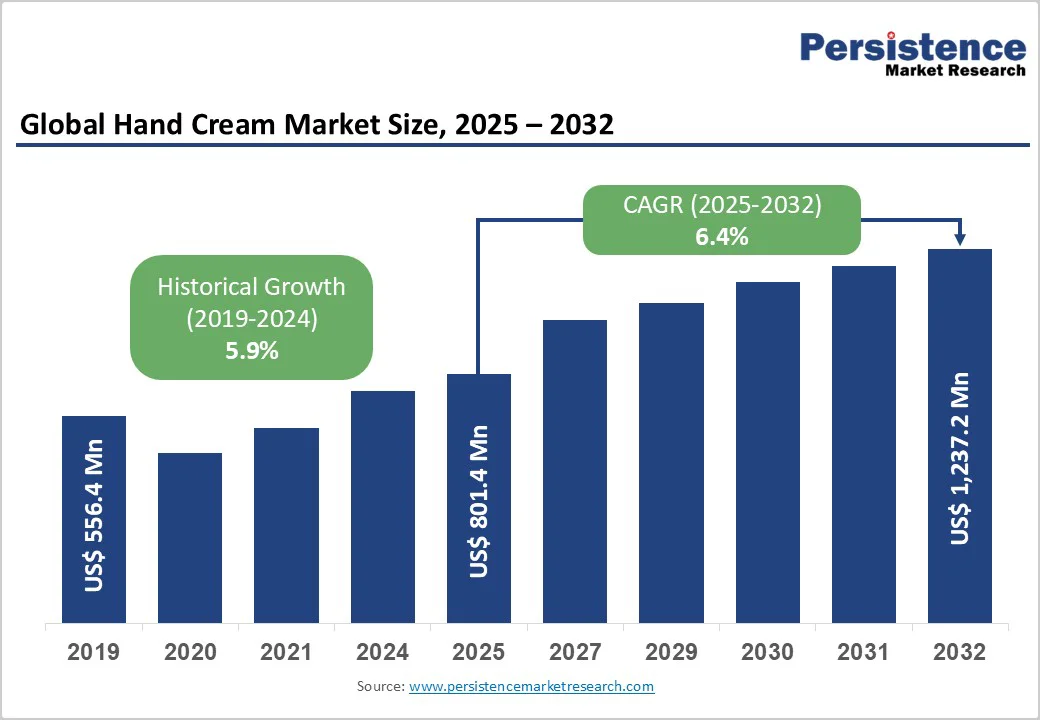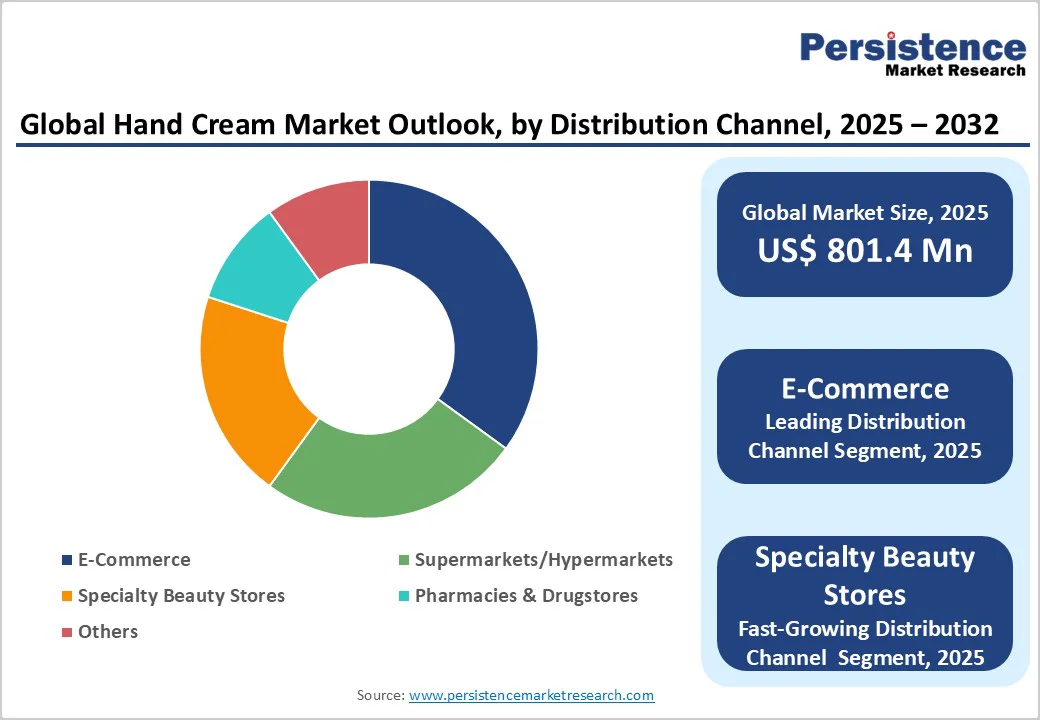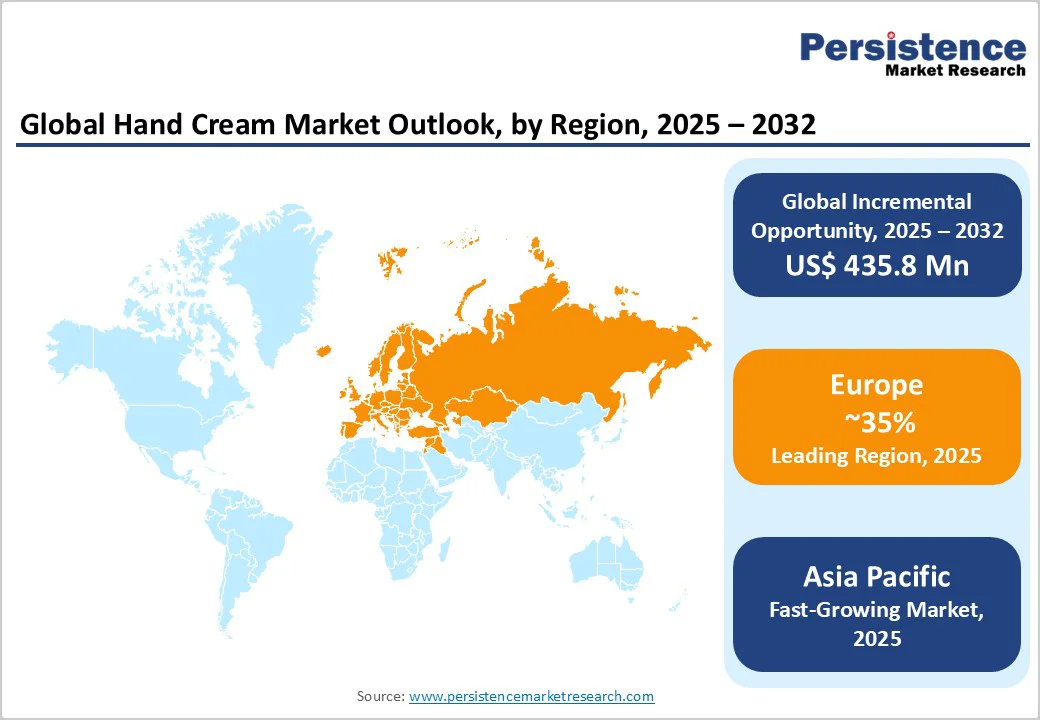ID: PMRREP32551| 230 Pages | 9 Nov 2025 | Format: PDF, Excel, PPT* | Consumer Goods

The global hand cream market size is likely to be valued US$801.4 million in 2025, anticipated to reach at US$1,237.2 million by 2032 with growing at a CAGR of 6.4% during the forecast period from 2025 to 2032.
The market is experiencing robust growth driven by increasing consumer awareness of skincare, rising demand for natural and organic products, and growing concerns about skin health due to frequent hand washing and environmental factors.
The market is further propelled by innovations in eco-friendly formulations and premium packaging, catering to preferences for sustainable and high-quality skincare. The growing acceptance of hand lotion as an essential daily care product, especially among younger demographics and men, is a key growth factor.
| Global Market Attribute | Key Insights |
|---|---|
|
Hand Cream Market Size (2025E) |
US$801.4 Mn |
|
Market Value Forecast (2032F) |
US$1,237.2 Mn |
|
Projected Growth (CAGR 2025 to 2032) |
6.4% |
|
Historical Market Growth (CAGR 2019 to 2024) |
5.9% |

The increasing consumer focus on skincare and preference for natural, organic products is a primary driver of the hand cream market. Consumers today are more knowledgeable about skin health, the effects of environmental stressors, and the importance of hydration and barrier protection, which has heightened interest in specialized hand care. Daily hand moisturizer usage is no longer viewed as merely cosmetic but as an essential aspect of personal wellness, with emphasis on preventing dryness, signs of aging, and skin damage from pollution and frequent handwashing. The demand for natural, organic, and sustainably sourced products is shaping consumer preferences and purchasing behaviour. Ingredients such as shea butter, coconut oil, aloe vera, and plant-based vitamins are highly favoured, as they are perceived as safer, gentler, and environmentally responsible.
Regulatory guidelines and certifications for natural products further reinforce consumer trust and influence buying decisions. Brands are responding by innovating with clean formulations, eco-friendly packaging, and multifunctional benefits such as anti-aging, SPF protection, and soothing properties. Marketing campaigns emphasizing transparency, ingredient efficacy, and sustainability resonate strongly with younger, health-conscious, and environmentally aware consumers.
Intense competition from alternative skincare products and price sensitivity pose significant restraints on market growth. While premium and organic formulations are highly effective, their higher costs often deter budget-conscious consumers. Mass-market lotions, DIY remedies, and multipurpose moisturizers remain attractive alternatives, capturing a significant portion of the hydration-focused segment.
Regulatory compliance for natural, organic, or cruelty-free claims also poses challenges, as certifications and testing extend product development timelines, increase costs, and complicate market entry for smaller brands. Emerging brands often struggle to compete with established giants such as L’Oréal, Nivea, and Neutrogena, limiting their reach in competitive and price-sensitive regions. Shifting consumer preferences toward multifunctional products, such as hand creams with SPF, anti-aging, or fragrance features, force brands to continually innovate. The rise of e-commerce and social media has heightened marketing competition, requiring substantial investment in digital campaigns to maintain visibility.
The hand cream market is experiencing notable growth through the expansion of men’s grooming products and the adoption of eco-friendly packaging, reflecting evolving consumer preferences. Men’s grooming has emerged as a significant driver, fueled by rising awareness of skin health, professional appearance, and personal care routines among male consumers. Brands are increasingly launching hand creams tailored specifically for men, featuring lightweight, non-greasy textures, masculine fragrances, and multifunctional benefits such as hydration, anti-aging, and protection against environmental stressors.
Marketing campaigns targeting male audiences, coupled with influencer endorsements and social media engagement, are further accelerating adoption and establishing a loyal consumer base. Sustainability has become a central focus, with eco-conscious consumers seeking products that minimize environmental impact. Brands are investing in recyclable, biodegradable, and refillable packaging to appeal to environmentally aware shoppers.
Moisturizing dominates the market, accounting for 50% of the share in 2025, driven by universal consumer demand for hydration and skin barrier repair. Suitable for all skin types and climates, these creams address dryness, roughness, and environmental damage. Their essential role in daily skincare routines ensures consistent demand across age groups and geographic regions.
Anti-Aging is the fastest-growing segment, driven by rising consumer demand for wrinkle-reducing, firming, and skin-rejuvenating products. With increasing focus on youthful appearance and preventive skincare, brands are introducing advanced formulations containing peptides, hyaluronic acid, and vitamins, appealing to aging-conscious consumers seeking effective and luxurious hand care solutions.
Women lead with 65% share, driven by dedicated skincare routines and trends emphasizing hand health and aesthetics. Consumers increasingly seek moisturizing, anti-aging, and nourishing products tailored to female preferences. Social media influence, beauty campaigns, and premium product offerings further reinforce women’s leadership in hand lotion consumption worldwide.
Men are the fastest-growing, driven by increasing grooming awareness and demand for products designed specifically for male skin. Brands are introducing formulations with masculine fragrances, lightweight textures, and multifunctional benefits, appealing to health-conscious and style-oriented men. Rising marketing campaigns and influencer endorsements are further accelerating adoption in this demographic.
E-Commerce holds nearly 30% share, fueled by immersive in-store experiences and product trial opportunities. Urban consumers are drawn to personalized consultations, sampling stations, and expert guidance, which enhance brand engagement and purchase confidence. These stores effectively combine convenience, education, and sensory experiences, driving higher sales and loyalty in premium skincare segments.
Specialty Beauty Stores are the fastest-growing, fueled by immersive in-store experiences and product trial opportunities. Urban consumers are drawn to personalized consultations, sampling stations, and expert guidance, which enhance brand engagement and purchase confidence. These stores effectively combine convenience, education, and sensory experiences, driving higher sales and loyalty in premium skincare segments.

Europe holds about 35% market share, led by France and Germany emerging as the leading contributors. The region’s growth is strongly influenced by major cosmetic companies such as L’Oréal, whose extensive portfolio of premium and natural hand care products drives innovation, brand loyalty, and consumer trust. European consumers increasingly prioritize high-quality, safe, and ethically sourced ingredients, favouring creams enriched with natural extracts, vitamins, and moisturizing agents that cater to various skin types and concerns.
Regulatory frameworks in the European Union further shape the market by promoting natural, sustainable, and safe skincare formulations. Policies under the EU Cosmetics Regulation encourage the use of environmentally friendly ingredients and prohibit harmful chemicals, which has led brands to innovate and expand their natural hand moisturizer offerings. Germany’s strong consumer base, coupled with France’s historical leadership in skincare and beauty, provides a favourable environment for product launches, premium positioning, and R&D investment.
North America accounts for 25% in 2025, driven by robust consumer spending on beauty and personal care, particularly in the United States. Rising awareness of skincare and hand health, coupled with a growing preference for natural and organic products, is fueling demand for high-quality hand creams. Consumers increasingly seek formulations enriched with natural ingredients such as shea butter, aloe vera, and essential oils, reflecting the broader trend toward clean beauty and wellness-oriented personal care. Premium and niche brands are leveraging these preferences through targeted marketing, influencer partnerships, and e-commerce channels, reaching health-conscious and eco-aware consumers effectively.
The U.K., although part of Europe, mirrors North American trends. Retailers such as Boots and Superdrug are expanding their offerings of organic and eco-friendly hand creams to meet growing consumer demand. Wellness campaigns emphasizing natural ingredients, ethical sourcing, and sustainable packaging resonate strongly with consumers. Increasing interest in cruelty-free, recyclable, and biodegradable packaging is driving adoption, particularly among younger demographics.
Asia Pacific commands around 30% share and is the fastest-growing region, fueled by rapid urbanization, rising disposable incomes, and a booming beauty and personal care sector in countries such as China and India. The increasing awareness of skincare routines, combined with a growing preference for premium and natural products, has significantly boosted demand for high-quality hand creams. Consumers are seeking products that not only moisturize and protect but also offer anti-aging, nourishing, and fragrance-enhancing benefits.
China’s beauty market is expanding rapidly, supported by rising e-commerce penetration, social media influence, and growing interest in international and luxury brands. Similarly, India’s urban population is increasingly adopting modern skincare habits, with consumers favoring hand creams that combine functionality with natural ingredients such as aloe vera, shea butter, and essential oils. Retail modernization, including the growth of specialty stores, online marketplaces, and omnichannel distribution, has further enhanced accessibility and visibility for hand lotion products.

The global hand cream market is highly competitive, driven by increasing consumer awareness of skin health, cosmetic aesthetics, and eco-conscious choices. Key players are differentiating themselves through the development of natural and organic formulations, incorporating ingredients such as shea butter, aloe vera, coconut oil, and essential vitamins, which appeal to health-conscious consumers seeking gentle yet effective skin care solutions. Brands are prioritizing sustainable and innovative packaging, including recyclable tubes, biodegradable materials, and refillable containers, aligning with growing environmental concerns and regulatory pressures.
Digital marketing has become a critical tool for market players to engage consumers, particularly through social media, influencer partnerships, and e-commerce platforms. This approach allows brands to reach a wider audience, promote product benefits, and encourage brand loyalty in a crowded marketplace.
The global hand cream market is projected to reach US$801.4 Million in 2025, driven by rising skincare awareness and natural product demand.
Increasing consumer focus on hand care as part of daily skincare routines, including hydration, anti-aging, and protection from environmental stressors.
The market is poised to witness a CAGR of 6.4% from 2025 to 2032, supported by eco-friendly and anti-ageing innovations.
Expansion in men’s grooming and sustainable packaging offers opportunities for hand cream in natural anti-aging formulations.
L’Occitane, Beiersdorf AG, L’Oréal, Natura & Co, and Unilever lead through innovations in organic hand cream and e-commerce strategies.
| Report Attribute | Details |
|---|---|
|
Historical Data/Actuals |
2019 - 2024 |
|
Forecast Period |
2025 - 2032 |
|
Market Analysis |
Value: US$ Mn |
|
Geographical Coverage |
|
|
Segmental Coverage |
|
|
Competitive Analysis |
|
|
Report Highlights |
|
By Product Type
By End-use
By Distribution Channel
By Region
Delivery Timelines
For more information on this report and its delivery timelines please get in touch with our sales team.
About Author